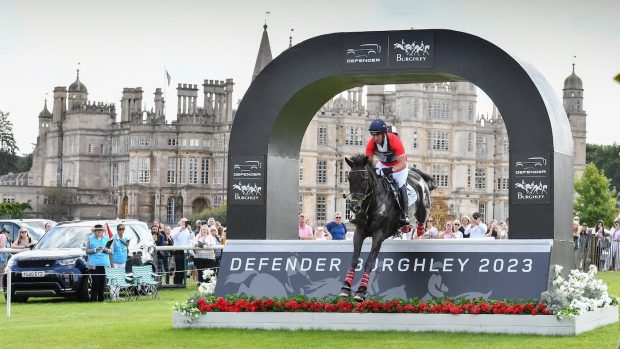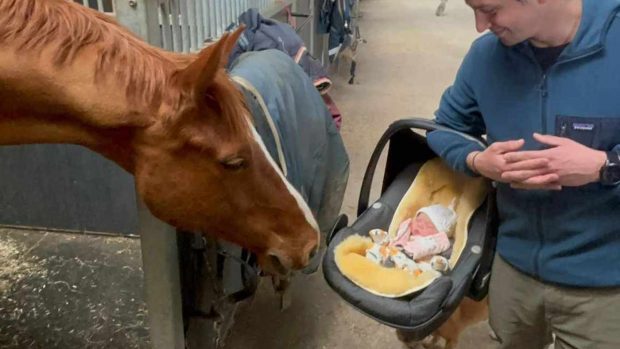With less than two weeks before cross-country day at the Land Rover Burghley Horse Trials, you have to be fairly certain your horse has done enough work by now to be ready for the event. It is totally unadvisable to try and cram any extra fitness, jumping or schooling in the last days before you leave. Ideally you want your horse to be fresh-minded with no aching muscles to be tackling a course like Burghley (although this could ring true for any event).
We don’t see professional athletes over-training in the lead up to a big competition — they have done all the work required in the appropriate timescale. I feel our horses deserve to adhere to the same rules. There is something to be said for us riders to feel slightly underprepared but the horses must be raring to go. If we riders work on everything 110% in the final days, there is a risk the horses turn up over-done with a lack of enthusiasm. That absolutely doesn’t mean I won’t be cantering, schooling or jumping — I do all the above but not to excess.
My Burghley mount, Ali (Malin Head Clover), is a remarkable little horse who keeps his fitness extraordinarily well. He has been slowly working through a gallop scheme since mid-June and this happens strictly every four days (which is the optimum time frame between gallops to increase fitness).
We do interval training on hilly, grass parkland that has perfect going both in winter and summer (hugely spoiling!). For me, galloping on grass and replicating a cross-country course is extremely important. Grass not only allows the natural slip of the hoof (therefore not jarring the joints) but it also means I can work both up and down hill, replicating the terrain we have to deal with when competing.
Before we start galloping, the horses will do a minimum of a 10 minute walk followed by two five minute trots, with a two minute breather gap. They are then limbered up enough to start canter work. The first of the three canters is always slowest and is at showjumping canter speed, then the final two switch been fast work and slower work, exactly the pace changing you will need to use when going cross-country.
Ali is now on three lots of seven minutes. Our fast spurts are a lot faster than they were 10 weeks ago and we are using more hill. As a rule, we only do road work the day after galloping to give the legs a chance to re-harden up as well as having to still use themselves up hills, which continues to add to their fitness. From time to time, after an hour’s road work, I do have a little jump so they are used to using their jumping muscles after a big day prior.
Another huge asset to my fitness regime is Jamie Magee’s water treadmill. This has been a complete game changer for Ali — I have never known him so strong through his body since using this machine. It maximises strength and conditions the muscles while minimising pressure on the legs and he LOVES it — winning! (Although him being stronger may cause more trouble for me stopping when out on course…!).
We haven’t competed Ali since Badminton, but what I have done is run round a flagged intermediate track once the competition was over. We did this fairly fast to practice using all paces while running and jumping for six minutes. For me it wasn’t an option to run round a track while in competition. Ali finds intermediate far too small and in a competition environment doesn’t respect the smaller fences, so the whole experience becomes a battle. With everyone gone home, Ali was alert and using his brain beautifully round the whole cross-country track. Dare I say it, he feels better than ever.
Next week we will be running through his four-star dressage test at West Wilts; a great competition where they do a pick your own test and still be in a show atmosphere.
Showjumping is something he has never found too easy since we’ve had him, with Richard Waygood’s advice I only ever jump a couple of fences in a row and then stop. We leave doing a whole course for when we have to — in the ring itself. He is such a wonderfully forward-thinking horse that if he is allowed to do too many, he becomes quicker not just between the fences, but also in the air. We want him to use his body as effectively as possible and that happens when he always thinks he is going to be pulled up.
Continued below…

*NEW* Lissa Green’s Burghley blog: my little Trojan horse with the biggest heart and a choppy Irish trot
Lissa Green, who will be tackling her first
To make sure he is in peak physical condition Ali has his chiropractor Winston Williams and physio Hannah Complin treating him regularly. We also scanned his legs to be on the safe side and finally have taken some bloods to make sure all are within normal range. With positive results from every corner of his health team we are literally just counting down the hours for when we get to load this incredible creature on to the lorry in pursuit of our second four-star dream.
Lissa



